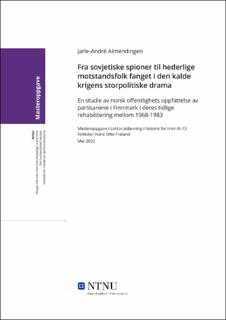| dc.contributor.advisor | Frøland, Hans Otto | |
| dc.contributor.author | Almendingen, Jarle-André | |
| dc.date.accessioned | 2022-09-20T17:20:23Z | |
| dc.date.available | 2022-09-20T17:20:23Z | |
| dc.date.issued | 2022 | |
| dc.identifier | no.ntnu:inspera:109398136:22972285 | |
| dc.identifier.uri | https://hdl.handle.net/11250/3019888 | |
| dc.description.abstract | Denne avhandlingen diskuterer endring i norsk offentlighets oppfattelse av partisanene i Finnmark mellom 1968-1983, samt i hvilken grad partisanenes rehabiliteringsprosess kunne attribueres til endring i deres offentlige profil. Mellom 1968-1971 så en de tidligste tegnene til rehabilitering av partisanene i Finnmark. Fjørtofts artikkelserie i 1968 bidro til å formidle om den urett som hadde blitt begått i overvåkingen av de tidligere motstandskjemperne. Eriksens utgivelse av Partisaner i Finnmark i 1969 bidro til å opplyse allmennheten om deres innsats under krigsårene. Plutselig så en antydninger til en endring i oppfattelse av partisanene i norsk offentlighet.
I årene 1972-1978 fortsatte denne oppfattelsesendringen å spre seg. Eriksen publiserte sin andre bok om partisanene – Partisaner i nord – i 1972 som bidro til å opplyse offentligheten ytterligere om partisanenes motstandsbevegelse. For offentligheten fremstod plutselig partisanenes innsats som lite påaktet og behandlingen av dem i etterkrigsårene som kritikkverdig. Denne oppfattelsen av partisanene ble forsterket ytterligere gjennom Mortensens artikkelserie i 1977, hvor tidligere partisaner turte å stå frem og kreve sin egen og sine avdøde kameraters rehabilitering.
I 1979-1983 forløp en rekke hendelser som skulle bidra ytterligere til partisanenes rehabilitering. Eriksen ga ut Partisaner i nord i 1979, Jensen publiserte sin artikkelserie i 1980, Fjørtoft utga Dramaet på Arnøy i 1981 og Lille-Moskva – den glemte krigen i 1983, mens kong Olav la ned en krans ved partisanbautaen i Kiberg samme år. De hadde vært de sovjetiske spionene svært få ville kjennes ved i 1968, men innen 1983 hadde bildet av dem som hederlige motstandsfolk fanget i den kalde krigens storpolitiske drama for alvor slått rot i offentligheten. Likevel vitner datidens forhold om at rehabiliteringen var på god vei, men ikke fullbyrdet.
Endring i offentlighetens oppfattelse av partisanene spilte naturligvis en viktig rolle i de rehabiliterende tiltakene. En kan likevel ikke utelukkende attribuere partisanenes rehabilitering til endring i deres offentlige profil. Dette begrunnes av at flere av hendelsene i deres rehabiliteringsprosess brøt med den daværende oppfattelsen av partisanene, mens andre trolig oppstod som et resultat av oppfattelsesendringen. Et mer realistisk bilde av oppfattelsesendringens betydning for rehabiliteringen var at endring i oppfattelse både kunne være et resultat av de rehabiliterende tiltakene, men også opptre som en motivasjonsfaktor for andre rehabiliterende tiltak. | |
| dc.description.abstract | This paper discusses change in the Norwegian public’s perception of the partisans in Finnmark during 1968-1983, as well as to what degree the rehabilitation process could be attributed to change in their public profile. Between 1968-1971, it was possible to observe the earliest signs of rehabilitation of the partisans in Finnmark. Fjørtoft’s article series in 1968 contributed to convey the injustice that had occurred in the surveillance of the former resistance fighters. Eriksen’s publication of Partisaner i Finnmark in 1969 contributed to enlighten the public about their efforts during the war years. Suddenly it was possible to observe hints of change in perception of the partisans in the Norwegian public.
During the years 1972-1978 the change in perception kept spreading. Eriksen published his second book about the partisans – Partisaner i nord – in 1972 which contributed to enlighten the public even more about the partisan’s resistance movement. To the public, the partisan’s efforts suddenly appeared to be far too unnoticed and the treatment of them during the post-war period seemed worthy of criticism. This perception of the partisans was further reinforced through Mortensen’s article series in 1977, where former partisans dared to come forth and demand rehabilitation on behalf of themselves as well as their dead comrades.
In 1979-1983, further events occurred which would contribute to the rehabilitation of the partisans. Eriksen published Partisaner i nord in 1979, Jensen published his article series in 1980, Fjørtoft published Dramaet på Arnøy in 1981 and Lille-Moskva – den glemte krigen in 1983, whilst King Olav put down a wreath at the partisan monument in Kiberg the same year. They had been the Soviet spies that very few wanted to be associated with in 1968, but by 1983 the image of them as persistent resistance fighters trapped in the major political drama of the Cold War was about to establish itself within the public. However, conditions at the time shows that the rehabilitation was underway, but not quite finished.
Change in the public’s perception of the partisans naturally played an important role in the rehabilitative measures. However, it is not possible to solely attribute the rehabilitation of the partisans to change in their public profile. This is due to multiple incidents in their rehabilitation process which broke with the public’s perception of the partisans at the time, whilst other rehabilitative measures probably occurred because of the perception change. A more realistic image of the perception change’s importance to the rehabilitation was that the change in perception could act as a result of the rehabilitative measures, as well as a motivating factor for other rehabilitative measures. | |
| dc.language | nob | |
| dc.publisher | NTNU | |
| dc.title | Fra sovjetiske spioner til hederlige motstandsfolk fanget i den kalde krigens storpolitiske drama | |
| dc.type | Master thesis | |
